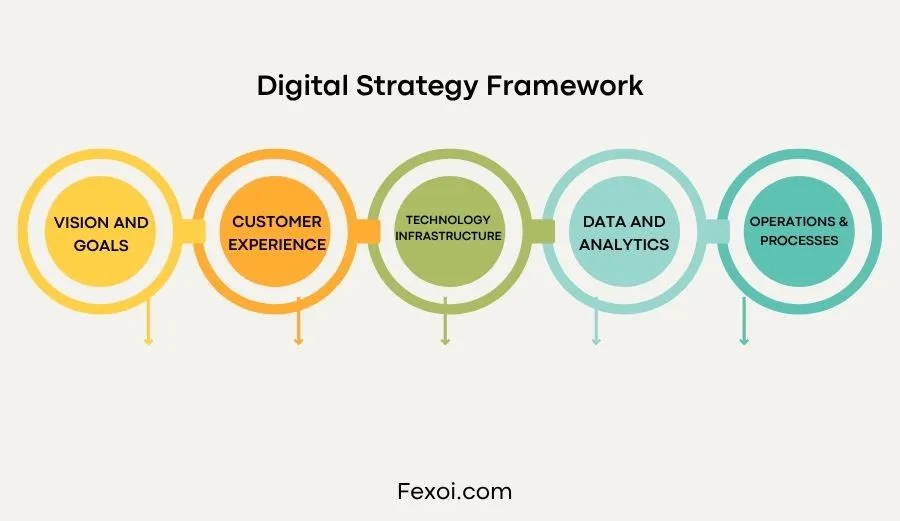Why a Digital Strategy Framework Matters
A strong digital strategy framework is essential for modern businesses aiming to compete and grow in today’s technology-driven world. It provides a structured roadmap for integrating digital technologies into all aspects of operations, marketing, customer experience, and innovation. As organizations face rapid digital disruption, a clear framework helps align teams, prioritize investments, and deliver measurable outcomes.
Statista projects that worldwide spending on digital transformation technologies will climb beyond $3.4 trillion by 2026. Without a structured approach, businesses risk wasting resources on fragmented initiatives. That’s where a digital strategy framework comes in.
What Is a Digital Strategy Framework?
A digital strategy framework is a structured model that guides how a business leverages digital technologies to achieve strategic goals. It outlines key pillars such as:
- Vision and Goals
- Customer Experience
- Technology Infrastructure
- Data and Analytics
- Operations and Processes
- Governance and Risk Management
These components ensure all digital initiatives align with broader business objectives, creating a cohesive and agile environment for growth.
Core Elements of a Digital Strategy Planning Process
Effective digital strategy planning involves a step-by-step process:
- Define Business Objectives: Align digital goals with overall business strategy.
- Assess Current State: Analyze current digital capabilities, platforms, and user journeys.
- Identify Gaps and Opportunities: Spot inefficiencies and new digital possibilities.
- Build a Roadmap: Prioritize initiatives based on ROI, feasibility, and alignment.
- Implement and Monitor: Deploy technologies and continuously track performance metrics.
This approach ensures clarity, accountability, and results.
Why You Need a Digital Transformation Strategy Framework
A well-structured digital transformation strategy framework does more than support IT upgrades. It helps businesses:
- Stay competitive in evolving markets
- Improve customer satisfaction
- Streamline operations
- Enable data-driven decisions
- Enhance agility and innovation
For instance, companies using real-time analytics and cloud infrastructure experience faster time-to-market and improved efficiency.
“Digital strategy isn’t just about technology—it’s about transforming your business model,” says Harvard Business School’s Professor Sunil Gupta.
Popular Framework Models to Consider
Multiple established digital strategy models can provide a solid foundation:
- McKinsey 7S Model: Aligns seven internal elements (Strategy, Structure, Systems, Shared Values, Skills, Style, and Staff).
- MIT Digital Capability Framework: Focuses on customer experience, operations, and business models.
- The Digital Maturity Model by Deloitte assesses an organization’s progress across five defined stages of digital development.
- Choosing the right model depends on your business size, industry, and transformation goals.
Examples of Successful Digital Strategy Frameworks
- Nike: Unified e-commerce and personalized customer experiences using data and mobile-first strategies.
- Netflix: Built a cloud-native platform with AI-driven recommendations.
- Walmart: Leveraged automation and real-time analytics to optimize supply chains and customer service.
These examples show how a robust digital strategy framework can lead to innovation and competitive advantage.
FAQ
Q1: What is the purpose of a digital strategy framework?
A digital strategy framework helps businesses align digital initiatives with overall goals, prioritize investments, and manage change effectively.
Q2: How is digital strategy different from digital transformation?
Digital strategy focuses on planning and alignment, while digital transformation involves executing and embedding digital changes across the organization.
Q3: Which industries benefit most from digital strategy frameworks?
Virtually all industries—especially retail, healthcare, finance, and manufacturing—can gain from strategic digital planning.
Q4: How often should a digital strategy be reviewed?
Ideally, businesses should review their strategy every 6–12 months to adapt to new trends, technologies, and market shifts.
Conclusion
Building a powerful digital strategy framework is no longer optional—it’s a competitive necessity. By clearly defining goals, aligning teams, and leveraging the right technologies, businesses can transform challenges into opportunities.
Whether you’re just starting your digital journey or refining your existing roadmap, a well-executed strategy ensures long-term success in an evolving digital landscape.
Written by Faizan Rasool, a journalist passionate about delivering clear, helpful content in real estate, finance, tech, and lifestyle.







